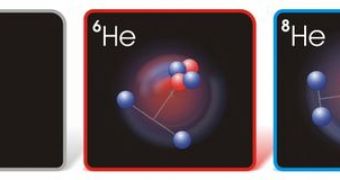Although on Earth helium gas is relatively rare and mostly extracted from natural gas deposits, in the universe helium is the second most abundant element after hydrogen. The U.S. Department of Energy Argonne National Laboratory have been successful recently in creating a helium-8 isotope, isolate it and measure its characteristics, findings that could provide with new information for the nuclear theory understanding and in the study of neutron stars.
Helium's most stable isotopes usually have two - or even one - neutrons packed into the nucleus aside with two protons, but unstable isotopes may exist for short periods of time as well. For example, the helium-6 and helium-8 isotopes contain a additional number of electrons located in the close proximity of the central nuclear core. Such isotopes were first created back in 2004 at the Argonne National Laboratory, when the physicists were able to determine the extra two neutrons in the nucleus of the helium-6 isotope implied in an asymmetrical configuration around the central core, sitting only a few trillionths of a millimeter away from it.
In the newly conducted study, researchers from Argonne have shown that the four extra neutrons in the helium-8 isotope have a configuration very different from that observed in the helium-6 isotope, which alters the dynamics of the atomic nucleus.
Both isotopes are extremely radioactive, meaning that physicists had little time to spare to measure the isotope's characteristics before it decayed; helium-8 has a half-life of only one tenth of a second. In order to have access to relatively high quantities of helium-8 isotopes the Argonne facility started a collaboration with the GANIL cyclotron facility in France.
Nevertheless, cyclotron accelerators also produce byproduct atoms resulted during the splitting process, which are greater in quantity than the helium-8 isotope. To separate them, physicists created a so-called atom trap, with the help of six powerful laser beams. This filtering process is able to capture a helium-8 isotope once every two minutes, basically stopping it in its tracks in order to shine it with a separate laser system that would match the internal resonating frequency of the atom, determining the helium-8 isotope to reflect a maximum amount of light that would signal that the atom was collected.
As one might expect, each chemical element has a different resonant frequency which gives scientists the opportunity to study it just with the help of reflected light. The same is also true for isotopes, allowing physicists to analyze the nucleus structure of helium-8 atoms. Argonne National Laboratory argues that the GANIL cyclotron facility could produce 1,000 times more unstable isotope, if it were to receive a upgrade, enabling the possibility of conducting studies on matter that cannot be made through any other means.

 14 DAY TRIAL //
14 DAY TRIAL //